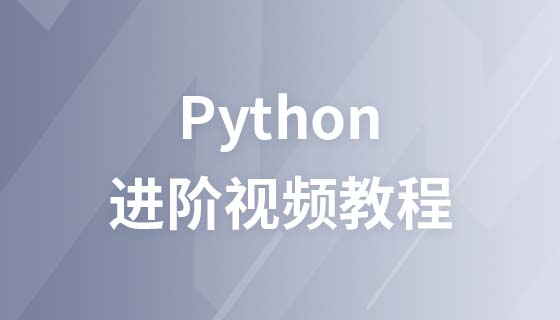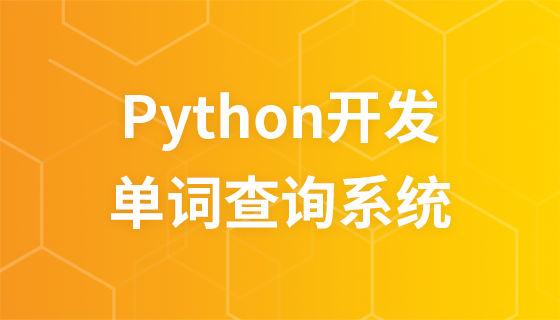這篇文章為大家帶來了關於python的相關知識,其中主要介紹了關於Pandas的相關問題,包括了Pandas的索引操作、對齊運算和函數應用等等,下面一起來看一下,希望對大家有幫助。

推薦學習:python影片教學

那麼問題來了:
numpy已經能夠幫助我們處理數據,能夠結合matplotlib解決我們數據分析的問題,那麼pandas學習的目的在什麼地方呢?
numpy能夠幫我們處理處理數值型數據,但是這還不夠, 很多時候,我們的數據除了數值之外,還有字串,還有時間序列等
#例如:我們透過爬蟲獲取到了儲存在資料庫中的資料
所以,pandas出現了。
Pandas的名稱來自於面板資料(panel data)
Pandas是一個強大的分析結構化資料的工具集,基於NumPy構建,提供了高級資料結構和資料操作工具,它是使Python成為強大而高效的資料分析環境的重要因素之一。
一個強大的分析和操作大型結構化資料集所需的工具集
基礎是NumPy,提供了高效能矩陣的運算
提供了大量能夠快速且方便地處理資料的函數和方法
應用於資料探勘,資料分析
提供資料清洗功能
官網
http://pandas.pydata.org/
索引物件Index
範例程式碼:
print(type(ser_obj.index))print(type(df_obj2.index))print(df_obj2.index)
執行結果:
<class> <class> Int64Index([0, 1, 2, 3], dtype='int64')</class></class>
範例程式碼:
# 索引对象不可变df_obj2.index[0] = 2
執行結果:
---------------------------------------------------------------------------TypeError Traceback (most recent call last)<ipython-input-23-7f40a356d7d1> in <module>()
1 # 索引对象不可变----> 2 df_obj2.index[0] = 2/Users/Power/anaconda/lib/python3.6/site-packages/pandas/indexes/base.py in __setitem__(self, key, value)
1402
1403 def __setitem__(self, key, value):-> 1404 raise TypeError("Index does not support mutable operations")
1405
1406 def __getitem__(self, key):TypeError: Index does not support mutable operations</module></ipython-input-23-7f40a356d7d1>範例程式碼:
ser_obj = pd.Series(range(5), index = ['a', 'b', 'c', 'd', 'e'])print(ser_obj.head())
運行結果:
a 0 b 1 c 2 d 3 e 4 dtype: int64
ser_obj['label'], ser_obj[pos]
範例程式碼:
# 行索引print(ser_obj['b'])print(ser_obj[2])
執行結果:
1 2
ser_obj[2:4], ser_obj['label1': 'label3']
#注意,依索引名切片操作時,是包含終止索引的。
範例程式碼:
# 切片索引print(ser_obj[1:3])print(ser_obj['b':'d'])
運行結果:
b 1 c 2 dtype: int64 b 1 c 2 d 3 dtype: int64
##ser_obj[['label1', 'label2', 'label3']]範例程式碼:
# 不连续索引print(ser_obj[[0, 2, 4]])print(ser_obj[['a', 'e']])
a 0 c 2 e 4 dtype: int64 a 0 e 4 dtype: int64
# 布尔索引ser_bool = ser_obj > 2print(ser_bool)print(ser_obj[ser_bool])print(ser_obj[ser_obj > 2])
a False b False c False d True e True dtype: bool d 3 e 4 dtype: int64 d 3 e 4 dtype: int64
import numpy as np df_obj = pd.DataFrame(np.random.randn(5,4), columns = ['a', 'b', 'c', 'd'])print(df_obj.head())
a b c d 0 -0.241678 0.621589 0.843546 -0.383105 1 -0.526918 -0.485325 1.124420 -0.653144 2 -1.074163 0.939324 -0.309822 -0.209149 3 -0.716816 1.844654 -2.123637 -1.323484 4 0.368212 -0.910324 0.064703 0.486016
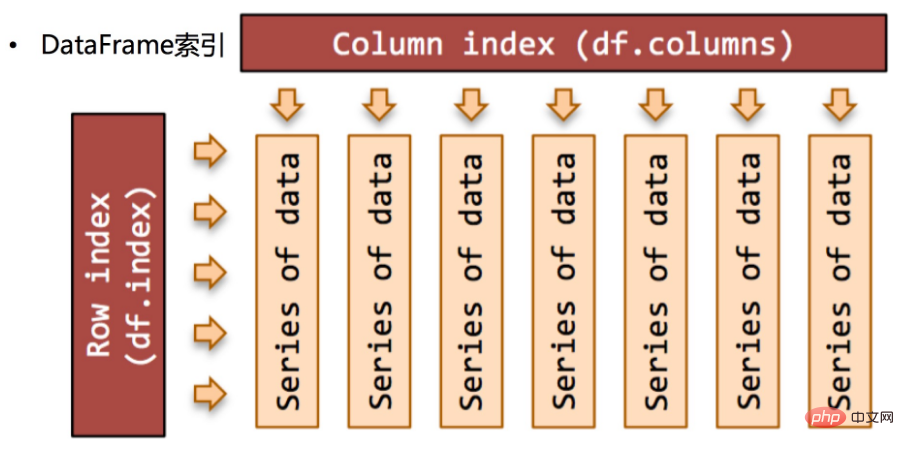
df_obj[['label']]範例程式碼:
# 列索引print(df_obj['a']) # 返回Series类型
0 -0.241678 1 -0.526918 2 -1.074163 3 -0.716816 4 0.368212 Name: a, dtype: float64
df_obj[['label1', 'label2']]範例程式碼:
# 不连续索引print(df_obj[['a','c']])
a c 0 -0.241678 0.843546 1 -0.526918 1.124420 2 -1.074163 -0.309822 3 -0.716816 -2.123637 4 0.368212 0.064703
1. loc 標籤索引
DataFrame 不能直接切片,可以透過loc來做切片loc是基於標籤名的索引,也就是我們自訂的索引名範例程式碼:
# 标签索引 loc# Seriesprint(ser_obj['b':'d'])print(ser_obj.loc['b':'d'])# DataFrameprint(df_obj['a'])# 第一个参数索引行,第二个参数是列print(df_obj.loc[0:2, 'a'])
b 1 c 2 d 3 dtype: int64 b 1 c 2 d 3 dtype: int64 0 -0.241678 1 -0.526918 2 -1.074163 3 -0.716816 4 0.368212 Name: a, dtype: float64 0 -0.241678 1 -0.526918 2 -1.074163 Name: a, dtype: float64
作用和loc一樣,不過是基於索引編號來索引範例程式碼:
# 整型位置索引 iloc# Seriesprint(ser_obj[1:3])print(ser_obj.iloc[1:3])# DataFrameprint(df_obj.iloc[0:2, 0]) # 注意和df_obj.loc[0:2, 'a']的区别
b 1 c 2 dtype: int64 b 1 c 2 dtype: int64 0 -0.241678 1 -0.526918 Name: a, dtype: float64
ix是以上二者的綜合,既可以使用索引編號,又可以使用自訂索引,要視情況不同來使用,如果索引既有數字又有英文,那麼這種方式是不建議使用的,容易導致定位的混亂。範例程式碼:
# 混合索引 ix# Seriesprint(ser_obj.ix[1:3])print(ser_obj.ix['b':'c'])# DataFrameprint(df_obj.loc[0:2, 'a'])print(df_obj.ix[0:2, 0])
b 1 c 2 dtype: int64 b 1 c 2 dtype: int64 0 -0.241678 1 -0.526918 2 -1.074163 Name: a, dtype: float64
注意
DataFrame索引操作,可將其視為ndarray的索引操作標籤的切片索引是包含末尾位置的#2. Pandas的對齊運算
Pandas的對齊運算是資料清洗的重要過程,可以依索引對齊運算,如果沒對齊的位置則補NaN,最後也可以填入NaN
示例代码:
s1 = pd.Series(range(10, 20), index = range(10))s2 = pd.Series(range(20, 25), index = range(5))print('s1: ' )print(s1)print('') print('s2: ')print(s2)运行结果:
s1: 0 10 1 11 2 12 3 13 4 14 5 15 6 16 7 17 8 18 9 19 dtype: int64 s2: 0 20 1 21 2 22 3 23 4 24 dtype: int64
示例代码:
# Series 对齐运算s1 + s2
运行结果:
0 30.0 1 32.0 2 34.0 3 36.0 4 38.0 5 NaN 6 NaN 7 NaN 8 NaN 9 NaN dtype: float64
示例代码:
df1 = pd.DataFrame(np.ones((2,2)), columns = ['a', 'b'])df2 = pd.DataFrame(np.ones((3,3)), columns = ['a', 'b', 'c'])print('df1: ')print(df1)print('') print('df2: ')print(df2)运行结果:
df1: a b 0 1.0 1.0 1 1.0 1.0 df2: a b c 0 1.0 1.0 1.0 1 1.0 1.0 1.0 2 1.0 1.0 1.0
示例代码:
# DataFrame对齐操作df1 + df2
运行结果:
a b c0 2.0 2.0 NaN1 2.0 2.0 NaN2 NaN NaN NaN
使用
add,sub,p,mul的同时,通过
fill_value指定填充值,未对齐的数据将和填充值做运算
示例代码:
print(s1)print(s2)s1.add(s2, fill_value = -1)print(df1)print(df2)df1.sub(df2, fill_value = 2.)
运行结果:
# print(s1)0 101 112 123 134 145 156 167 178 189 19dtype: int64# print(s2)0 201 212 223 234 24dtype: int64# s1.add(s2, fill_value = -1)0 30.01 32.02 34.03 36.04 38.05 14.06 15.07 16.08 17.09 18.0dtype: float64# print(df1) a b0 1.0 1.01 1.0 1.0# print(df2) a b c0 1.0 1.0 1.01 1.0 1.0 1.02 1.0 1.0 1.0# df1.sub(df2, fill_value = 2.) a b c0 0.0 0.0 1.01 0.0 0.0 1.02 1.0 1.0 1.0
算术方法表:
| 方法 | 描述 |
|---|---|
| add,radd | 加法(+) |
| sub,rsub | 减法(-) |
| p,rp | 除法(/) |
| floorp,rfllorp | 整除(//) |
| mul,rmul | 乘法(*) |
| pow,rpow | 幂次方(**) |
示例代码:
# Numpy ufunc 函数df = pd.DataFrame(np.random.randn(5,4) - 1)print(df)print(np.abs(df))
运行结果:
0 1 2 3 0 -0.062413 0.844813 -1.853721 -1.980717 1 -0.539628 -1.975173 -0.856597 -2.612406 2 -1.277081 -1.088457 -0.152189 0.530325 3 -1.356578 -1.996441 0.368822 -2.211478 4 -0.562777 0.518648 -2.007223 0.059411 0 1 2 3 0 0.062413 0.844813 1.853721 1.980717 1 0.539628 1.975173 0.856597 2.612406 2 1.277081 1.088457 0.152189 0.530325 3 1.356578 1.996441 0.368822 2.211478 4 0.562777 0.518648 2.007223 0.059411
示例代码:
# 使用apply应用行或列数据#f = lambda x : x.max()print(df.apply(lambda x : x.max()))
运行结果:
0 -0.062413 1 0.844813 2 0.368822 3 0.530325 dtype: float64
注意指定轴的方向,默认axis=0,方向是列
示例代码:
# 指定轴方向,axis=1,方向是行print(df.apply(lambda x : x.max(), axis=1))
运行结果:
0 0.844813 1 -0.539628 2 0.530325 3 0.368822 4 0.518648 dtype: float64
示例代码:
# 使用applymap应用到每个数据f2 = lambda x : '%.2f' % xprint(df.applymap(f2))
运行结果:
0 1 2 3 0 -0.06 0.84 -1.85 -1.98 1 -0.54 -1.98 -0.86 -2.61 2 -1.28 -1.09 -0.15 0.53 3 -1.36 -2.00 0.37 -2.21 4 -0.56 0.52 -2.01 0.06
sort_index()
排序默认使用升序排序,ascending=False 为降序排序
示例代码:
# Seriess4 = pd.Series(range(10, 15), index = np.random.randint(5, size=5))print(s4)# 索引排序s4.sort_index() # 0 0 1 3 3
运行结果:
0 10 3 11 1 12 3 13 0 14 dtype: int64 0 10 0 14 1 12 3 11 3 13 dtype: int64
对DataFrame操作时注意轴方向
示例代码:
# DataFramedf4 = pd.DataFrame(np.random.randn(3, 5), index=np.random.randint(3, size=3), columns=np.random.randint(5, size=5))print(df4)df4_isort = df4.sort_index(axis=1, ascending=False)print(df4_isort) # 4 2 1 1 0
运行结果:
1 4 0 1 2 2 -0.416686 -0.161256 0.088802 -0.004294 1.164138 1 -0.671914 0.531256 0.303222 -0.509493 -0.342573 1 1.988321 -0.466987 2.787891 -1.105912 0.889082 4 2 1 1 0 2 -0.161256 1.164138 -0.416686 -0.004294 0.088802 1 0.531256 -0.342573 -0.671914 -0.509493 0.303222 1 -0.466987 0.889082 1.988321 -1.105912 2.787891
sort_values(by=‘column name’)
根据某个唯一的列名进行排序,如果有其他相同列名则报错。
示例代码:
# 按值排序df4_vsort = df4.sort_values(by=0, ascending=False)print(df4_vsort)
运行结果:
1 4 0 1 2 1 1.988321 -0.466987 2.787891 -1.105912 0.889082 1 -0.671914 0.531256 0.303222 -0.509493 -0.342573 2 -0.416686 -0.161256 0.088802 -0.004294 1.164138
示例代码:
df_data = pd.DataFrame([np.random.randn(3), [1., 2., np.nan], [np.nan, 4., np.nan], [1., 2., 3.]])print(df_data.head())
运行结果:
0 1 2 0 -0.281885 -0.786572 0.487126 1 1.000000 2.000000 NaN 2 NaN 4.000000 NaN 3 1.000000 2.000000 3.000000
示例代码:
# isnullprint(df_data.isnull())
运行结果:
0 1 2 0 False False False 1 False False True 2 True False True 3 False False False
根据axis轴方向,丢弃包含NaN的行或列。 示例代码:
# dropnaprint(df_data.dropna()) # 默认是按行print(df_data.dropna(axis=1)) # axis=1是按列
运行结果:
0 1 2 0 -0.281885 -0.786572 0.487126 3 1.000000 2.000000 3.000000 1 0 -0.786572 1 2.000000 2 4.000000 3 2.000000
示例代码:
# fillnaprint(df_data.fillna(-100.))
运行结果:
0 1 2 0 -0.281885 -0.786572 0.487126 1 1.000000 2.000000 -100.000000 2 -100.000000 4.000000 -100.000000 3 1.000000 2.000000 3.000000
下面创建一个Series, 在输入索引Index时,输入了由两个子list组成的list,第一个子list是外层索引,第二个list是内层索引。
示例代码:
import pandas as pdimport numpy as np ser_obj = pd.Series(np.random.randn(12),index=[ ['a', 'a', 'a', 'b', 'b', 'b', 'c', 'c', 'c', 'd', 'd', 'd'], [0, 1, 2, 0, 1, 2, 0, 1, 2, 0, 1, 2] ])print(ser_obj)
运行结果:
a 0 0.099174 1 -0.310414 2 -0.558047 b 0 1.742445 1 1.152924 2 -0.725332 c 0 -0.150638 1 0.251660 2 0.063387 d 0 1.080605 1 0.567547 2 -0.154148 dtype: float64
打印这个Series的索引类型,显示是MultiIndex
直接将索引打印出来,可以看到有lavels,和labels两个信息。levels表示两个层级中分别有那些标签,labels是每个位置分别是什么标签。
示例代码:
print(type(ser_obj.index))print(ser_obj.index)
运行结果:
<class>MultiIndex(levels=[['a', 'b', 'c', 'd'], [0, 1, 2]], labels=[[0, 0, 0, 1, 1, 1, 2, 2, 2, 3, 3, 3], [0, 1, 2, 0, 1, 2, 0, 1, 2, 0, 1, 2]])</class>
根据索引获取数据。因为现在有两层索引,当通过外层索引获取数据的时候,可以直接利用外层索引的标签来获取。
当要通过内层索引获取数据的时候,在list中传入两个元素,前者是表示要选取的外层索引,后者表示要选取的内层索引。
ser_obj[‘outer_label’]
示例代码:
# 外层选取print(ser_obj['c'])
运行结果:
0 -1.362096 1 1.558091 2 -0.452313 dtype: float64
ser_obj[:, ‘inner_label’]
示例代码:
# 内层选取print(ser_obj[:, 2])
运行结果:
a 0.826662 b 0.015426 c -0.452313 d -0.051063 dtype: float64
常用于分组操作、透视表的生成等
.swaplevel( )交换内层与外层索引。
示例代码:
print(ser_obj.swaplevel())
运行结果:
0 a 0.099174 1 a -0.310414 2 a -0.558047 0 b 1.742445 1 b 1.152924 2 b -0.725332 0 c -0.150638 1 c 0.251660 2 c 0.063387 0 d 1.080605 1 d 0.567547 2 d -0.154148 dtype: float64
.sortlevel( )先对外层索引进行排序,再对内层索引进行排序,默认是升序。
示例代码:
# 交换并排序分层print(ser_obj.swaplevel().sortlevel())
运行结果:
0 a 0.099174 b 1.742445 c -0.150638 d 1.080605 1 a -0.310414 b 1.152924 c 0.251660 d 0.567547 2 a -0.558047 b -0.725332 c 0.063387 d -0.154148 dtype: float64
示例代码:
arr1 = np.random.rand(4,3)pd1 = pd.DataFrame(arr1,columns=list('ABC'),index=list('abcd'))f = lambda x: '%.2f'% x
pd2 = pd1.applymap(f).astype(float)pd2运行结果:
A B C a 0.87 0.26 0.67 b 0.69 0.89 0.17 c 0.94 0.33 0.04 d 0.35 0.46 0.29
axis=0 按列统计,axis=1按行统计
skipna 排除缺失值, 默认为True
示例代码:
pd2.sum() #默认把这一列的Series计算,所有行求和pd2.sum(axis='columns') #指定求每一行的所有列的和pd2.idxmax()#查看每一列所有行的最大值所在的标签索引,同样我们也可以通过axis='columns'求每一行所有列的最大值的标签索引
运行结果:
A 2.85 B 1.94 C 1.17 dtype: float64 a 1.80 b 1.75 c 1.31 d 1.10 dtype: float64 A c B b C a dtype: object

示例代码:
pd2.describe()#查看汇总
运行结果:
A B C count 4.000000 4.00000 4.000000mean 0.712500 0.48500 0.292500std 0.263613 0.28243 0.271585min 0.350000 0.26000 0.04000025% 0.605000 0.31250 0.13750050% 0.780000 0.39500 0.23000075% 0.887500 0.56750 0.385000max 0.940000 0.89000 0.670000
#百分比:除以原来的量pd2.pct_change() #查看行的百分比变化,同样指定axis='columns'列与列的百分比变化 A B C a NaN NaN NaN b -0.206897 2.423077 -0.746269c 0.362319 -0.629213 -0.764706d -0.627660 0.393939 6.250000
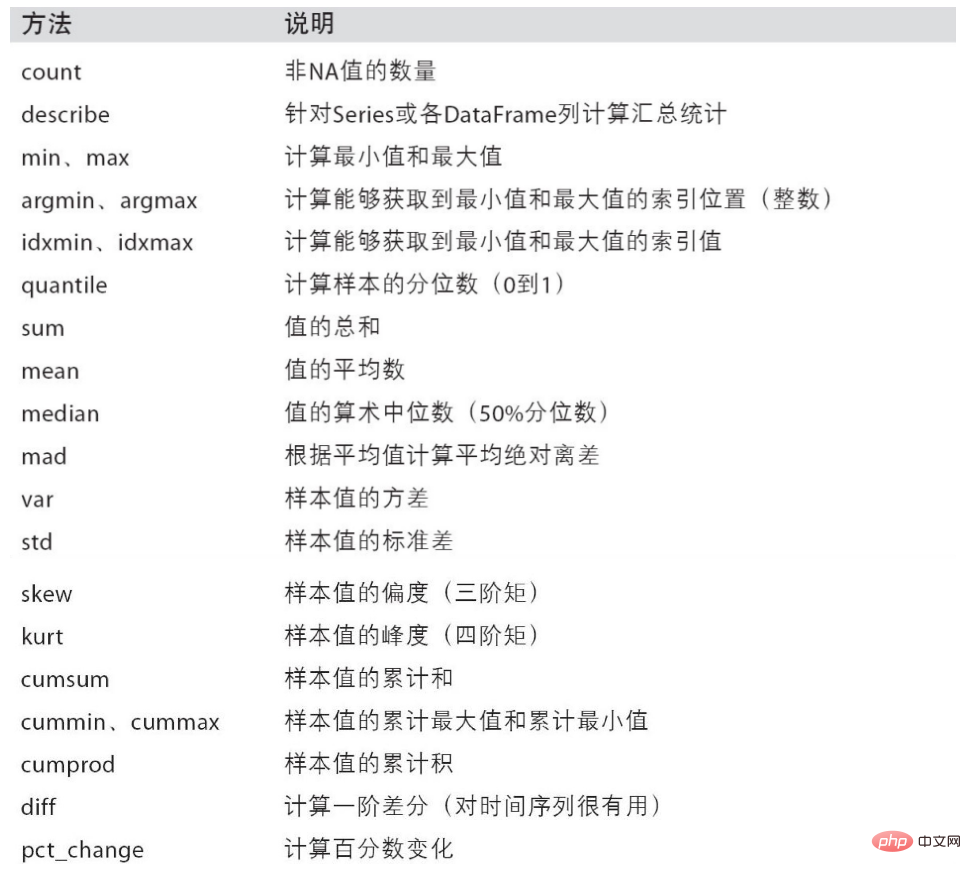

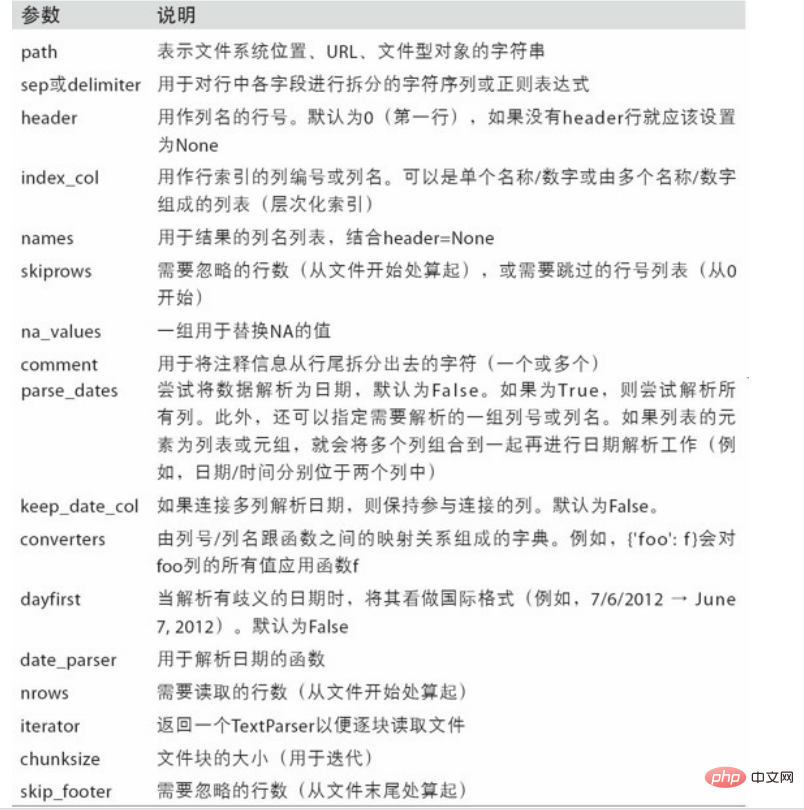
读取csv文件read_csv(file_path or buf,usecols,encoding):file_path:文件路径,usecols:指定读取的列名,encoding:编码
data = pd.read_csv('d:/test_data/food_rank.csv',encoding='utf8')data.head()
name num0 酥油茶 219.01 青稞酒 95.02 酸奶 62.03 糌粑 16.04 琵琶肉 2.0#指定读取的列名data = pd.read_csv('d:/test_data/food_rank.csv',usecols=['name'])data.head()
name0 酥油茶1 青稞酒2 酸奶3 糌粑4 琵琶肉#如果文件路径有中文,则需要知道参数engine='python'data = pd.read_csv('d:/数据/food_rank.csv',engine='python',encoding='utf8')data.head()
name num0 酥油茶 219.01 青稞酒 95.02 酸奶 62.03 糌粑 16.04 琵琶肉 2.0#建议文件路径和文件名,不要出现中文写入csv文件
DataFrame:to_csv(file_path or buf,sep,columns,header,index,na_rep,mode):file_path:保存文件路径,默认None,sep:分隔符,默认’,’ ,columns:是否保留某列数据,默认None,header:是否保留列名,默认True,index:是否保留行索引,默认True,na_rep:指定字符串来代替空值,默认是空字符,mode:默认’w’,追加’a’
**Series**:`Series.to_csv`\ (_path=None_,_index=True_,_sep='_,_'_,_na\_rep=''_,_header=False_,_mode='w'_,_encoding=None_\)
# 导入必要模块import pandas as pdfrom sqlalchemy import create_engine#初始化数据库连接#用户名root 密码 端口 3306 数据库 db2engine = create_engine('mysql+pymysql://root:@localhost:3306/db2')#查询语句sql = '''
select * from class;
'''#两个参数 sql语句 数据库连接df = pd.read_sql(sql,engine)df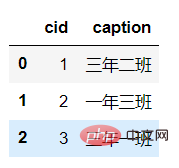
#新建df = pd.DataFrame({'id':[1,2,3,4],'num':[34,56,78,90]})df = pd.read_csv('ex1.csv')# #写入到数据库df.to_sql('df2',engine,index=False)print("ok")进入数据库查看
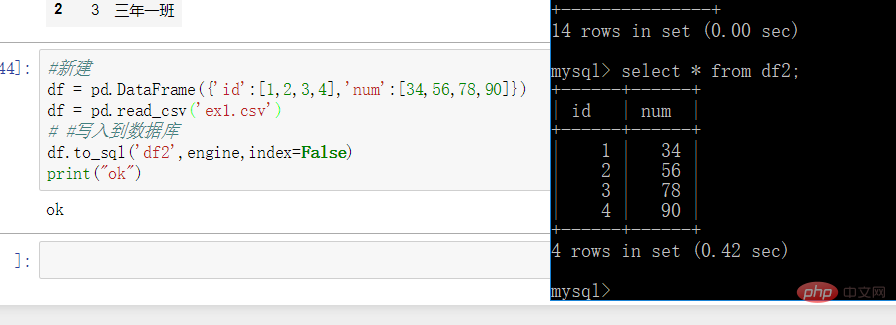
数据清洗是数据分析关键的一步,直接影响之后的处理工作
数据需要修改吗?有什么需要修改的吗?数据应该怎么调整才能适用于接下来的分析和挖掘?
是一个迭代的过程,实际项目中可能需要不止一次地执行这些清洗操作

duplicated\(\): 返回布尔型Series表示每行是否为重复行
示例代码:
import numpy as npimport pandas as pd
df_obj = pd.DataFrame({'data1' : ['a'] * 4 + ['b'] * 4,
'data2' : np.random.randint(0, 4, 8)})print(df_obj)print(df_obj.duplicated())运行结果:
# print(df_obj) data1 data20 a 31 a 22 a 33 a 34 b 15 b 06 b 37 b 0# print(df_obj.duplicated())0 False1 False2 True3 True4 False5 False6 False7 Truedtype: bool
示例代码:
print(df_obj.drop_duplicates())print(df_obj.drop_duplicates('data2'))运行结果:
# print(df_obj.drop_duplicates())
data1 data20 a 31 a 24 b 15 b 06 b 3# print(df_obj.drop_duplicates('data2'))
data1 data20 a 31 a 24 b 15 b 0根据map传入的函数对每行或每列进行转换
示例代码:
ser_obj = pd.Series(np.random.randint(0,10,10))print(ser_obj)print(ser_obj.map(lambda x : x ** 2))
运行结果:
# print(ser_obj)0 11 42 83 64 85 66 67 48 79 3dtype: int64# print(ser_obj.map(lambda x : x ** 2))0 11 162 643 364 645 366 367 168 499 9dtype: int64
示例代码:
# 单个值替换单个值print(ser_obj.replace(1, -100))# 多个值替换一个值print(ser_obj.replace([6, 8], -100))# 多个值替换多个值print(ser_obj.replace([4, 7], [-100, -200]))
运行结果:
# print(ser_obj.replace(1, -100))0 -1001 42 83 64 85 66 67 48 79 3dtype: int64# print(ser_obj.replace([6, 8], -100))0 11 42 -1003 -1004 -1005 -1006 -1007 48 79 3dtype: int64# print(ser_obj.replace([4, 7], [-100, -200]))0 11 -1002 83 64 85 66 67 -1008 -2009 3dtype: int64



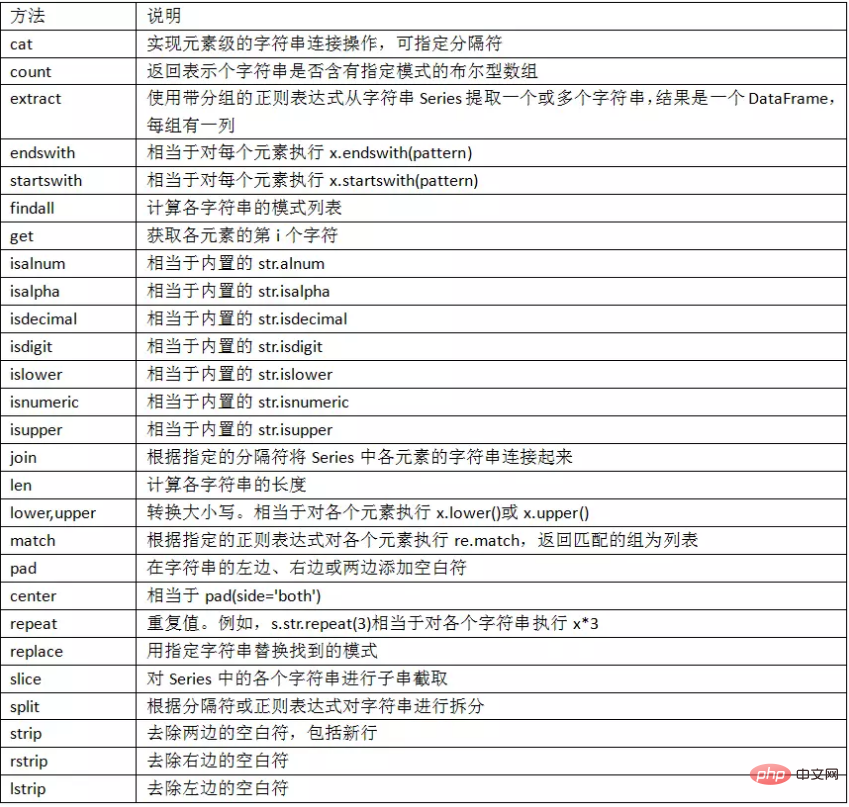
根据单个或多个键将不同DataFrame的行连接起来
类似数据库的连接操作
pd.merge:(left, right, how=‘inner’,on=None,left_on=None, right_on=None )
left:合并时左边的DataFrame
right:合并时右边的DataFrame
how:合并的方式,默认’inner’, ‘outer’, ‘left’, ‘right’
on:需要合并的列名,必须两边都有的列名,并以 left 和 right 中的列名的交集作为连接键
left_on: left Dataframe中用作连接键的列
right_on: right Dataframe中用作连接键的列
内连接 inner:对两张表都有的键的交集进行联合
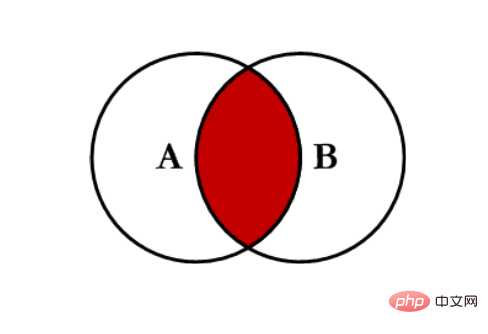

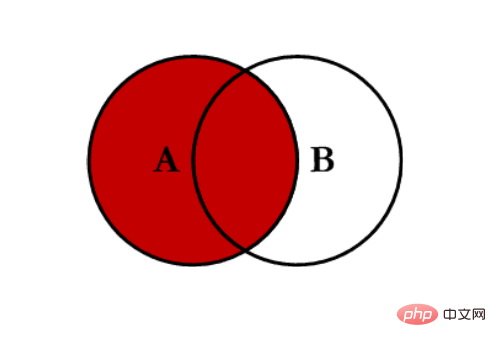
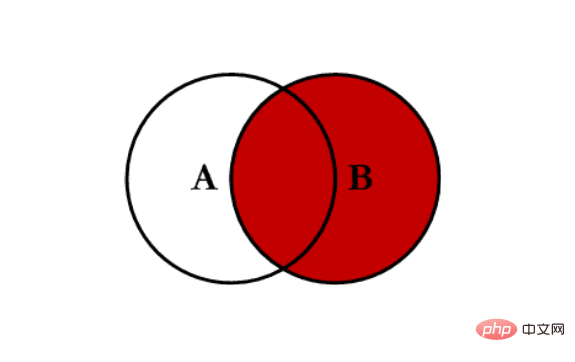
示例代码:
import pandas as pdimport numpy as np
left = pd.DataFrame({'key': ['K0', 'K1', 'K2', 'K3'],
'A': ['A0', 'A1', 'A2', 'A3'],
'B': ['B0', 'B1', 'B2', 'B3']})right = pd.DataFrame({'key': ['K0', 'K1', 'K2', 'K3'],
'C': ['C0', 'C1', 'C2', 'C3'],
'D': ['D0', 'D1', 'D2', 'D3']})pd.merge(left,right,on='key') #指定连接键key运行结果:
key A B C D0 K0 A0 B0 C0 D01 K1 A1 B1 C1 D12 K2 A2 B2 C2 D23 K3 A3 B3 C3 D3

示例代码:
left = pd.DataFrame({'key1': ['K0', 'K0', 'K1', 'K2'],
'key2': ['K0', 'K1', 'K0', 'K1'],
'A': ['A0', 'A1', 'A2', 'A3'],
'B': ['B0', 'B1', 'B2', 'B3']})right = pd.DataFrame({'key1': ['K0', 'K1', 'K1', 'K2'],
'key2': ['K0', 'K0', 'K0', 'K0'],
'C': ['C0', 'C1', 'C2', 'C3'],
'D': ['D0', 'D1', 'D2', 'D3']})pd.merge(left,right,on=['key1','key2']) #指定多个键,进行合并运行结果:
key1 key2 A B C D0 K0 K0 A0 B0 C0 D01 K1 K0 A2 B2 C1 D12 K1 K0 A2 B2 C2 D2

#指定左连接left = pd.DataFrame({'key1': ['K0', 'K0', 'K1', 'K2'],
'key2': ['K0', 'K1', 'K0', 'K1'],
'A': ['A0', 'A1', 'A2', 'A3'],
'B': ['B0', 'B1', 'B2', 'B3']})right = pd.DataFrame({'key1': ['K0', 'K1', 'K1', 'K2'],
'key2': ['K0', 'K0', 'K0', 'K0'],
'C': ['C0', 'C1', 'C2', 'C3'],
'D': ['D0', 'D1', 'D2', 'D3']})pd.merge(left, right, how='left', on=['key1', 'key2'])
key1 key2 A B C D0 K0 K0 A0 B0 C0 D01 K0 K1 A1 B1 NaN NaN2 K1 K0 A2 B2 C1 D13 K1 K0 A2 B2 C2 D24 K2 K1 A3 B3 NaN NaN
#指定右连接left = pd.DataFrame({'key1': ['K0', 'K0', 'K1', 'K2'],
'key2': ['K0', 'K1', 'K0', 'K1'],
'A': ['A0', 'A1', 'A2', 'A3'],
'B': ['B0', 'B1', 'B2', 'B3']})right = pd.DataFrame({'key1': ['K0', 'K1', 'K1', 'K2'],
'key2': ['K0', 'K0', 'K0', 'K0'],
'C': ['C0', 'C1', 'C2', 'C3'],
'D': ['D0', 'D1', 'D2', 'D3']})pd.merge(left, right, how='right', on=['key1', 'key2'])
key1 key2 A B C D0 K0 K0 A0 B0 C0 D01 K1 K0 A2 B2 C1 D12 K1 K0 A2 B2 C2 D23 K2 K0 NaN NaN C3 D3
默认是“内连接”(inner),即结果中的键是交集
how: 指定连接方式
“外连接”(outer),结果中的键是并集
示例代码:
left = pd.DataFrame({'key1': ['K0', 'K0', 'K1', 'K2'],
'key2': ['K0', 'K1', 'K0', 'K1'],
'A': ['A0', 'A1', 'A2', 'A3'],
'B': ['B0', 'B1', 'B2', 'B3']})right = pd.DataFrame({'key1': ['K0', 'K1', 'K1', 'K2'],
'key2': ['K0', 'K0', 'K0', 'K0'],
'C': ['C0', 'C1', 'C2', 'C3'],
'D': ['D0', 'D1', 'D2', 'D3']})
pd.merge(left,right,how='outer',on=['key1','key2'])运行结果:
key1 key2 A B C D0 K0 K0 A0 B0 C0 D01 K0 K1 A1 B1 NaN NaN2 K1 K0 A2 B2 C1 D13 K1 K0 A2 B2 C2 D24 K2 K1 A3 B3 NaN NaN5 K2 K0 NaN NaN C3 D3
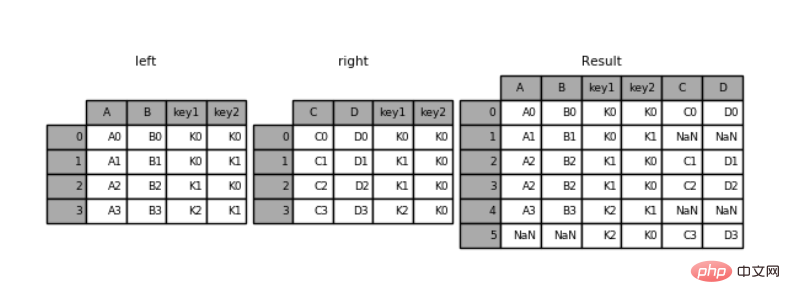
参数suffixes:默认为_x, _y
示例代码:
# 处理重复列名df_obj1 = pd.DataFrame({'key': ['b', 'b', 'a', 'c', 'a', 'a', 'b'],
'data' : np.random.randint(0,10,7)})df_obj2 = pd.DataFrame({'key': ['a', 'b', 'd'],
'data' : np.random.randint(0,10,3)})print(pd.merge(df_obj1, df_obj2, on='key', suffixes=('_left', '_right')))运行结果:
data_left key data_right0 9 b 11 5 b 12 1 b 13 2 a 84 2 a 85 5 a 8
参数left_index=True或right_index=True
示例代码:
# 按索引连接df_obj1 = pd.DataFrame({'key': ['b', 'b', 'a', 'c', 'a', 'a', 'b'],
'data1' : np.random.randint(0,10,7)})df_obj2 = pd.DataFrame({'data2' : np.random.randint(0,10,3)}, index=['a', 'b', 'd'])print(pd.merge(df_obj1, df_obj2, left_on='key', right_index=True))运行结果:
data1 key data20 3 b 61 4 b 66 8 b 62 6 a 04 3 a 05 0 a 0
沿轴方向将多个对象合并到一起
np.concatenate
示例代码:
import numpy as npimport pandas as pd arr1 = np.random.randint(0, 10, (3, 4))arr2 = np.random.randint(0, 10, (3, 4))print(arr1)print(arr2)print(np.concatenate([arr1, arr2])) # 默认axis=0,按行拼接print(np.concatenate([arr1, arr2], axis=1)) # 按列拼接
运行结果:
# print(arr1)[[3 3 0 8] [2 0 3 1] [4 8 8 2]]# print(arr2)[[6 8 7 3] [1 6 8 7] [1 4 7 1]]# print(np.concatenate([arr1, arr2])) [[3 3 0 8] [2 0 3 1] [4 8 8 2] [6 8 7 3] [1 6 8 7] [1 4 7 1]]# print(np.concatenate([arr1, arr2], axis=1)) [[3 3 0 8 6 8 7 3] [2 0 3 1 1 6 8 7] [4 8 8 2 1 4 7 1]]
注意指定轴方向,默认axis=0
join指定合并方式,默认为outer
Series合并时查看行索引有无重复
df1 = pd.DataFrame(np.arange(6).reshape(3,2),index=list('abc'),columns=['one','two'])df2 = pd.DataFrame(np.arange(4).reshape(2,2)+5,index=list('ac'),columns=['three','four'])pd.concat([df1,df2]) #默认外连接,axis=0
four one three two
a NaN 0.0 NaN 1.0b NaN 2.0 NaN 3.0c NaN 4.0 NaN 5.0a 6.0 NaN 5.0 NaN
c 8.0 NaN 7.0 NaN
pd.concat([df1,df2],axis='columns') #指定axis=1连接
one two three four
a 0 1 5.0 6.0b 2 3 NaN NaN
c 4 5 7.0 8.0#同样我们也可以指定连接的方式为innerpd.concat([df1,df2],axis=1,join='inner')
one two three four
a 0 1 5 6c 4 5 7 8将列索引旋转为行索引,完成层级索引
DataFrame->Series
示例代码:
import numpy as npimport pandas as pd df_obj = pd.DataFrame(np.random.randint(0,10, (5,2)), columns=['data1', 'data2'])print(df_obj)stacked = df_obj.stack()print(stacked)
运行结果:
# print(df_obj) data1 data20 7 91 7 82 8 93 4 14 1 2# print(stacked)0 data1 7 data2 91 data1 7 data2 82 data1 8 data2 93 data1 4 data2 14 data1 1 data2 2dtype: int64
将层级索引展开
Series->DataFrame
默认操作内层索引,即level=-1
示例代码:
# 默认操作内层索引print(stacked.unstack())# 通过level指定操作索引的级别print(stacked.unstack(level=0))
运行结果:
# print(stacked.unstack()) data1 data20 7 91 7 82 8 93 4 14 1 2# print(stacked.unstack(level=0)) 0 1 2 3 4data1 7 7 8 4 1data2 9 8 9 1 2
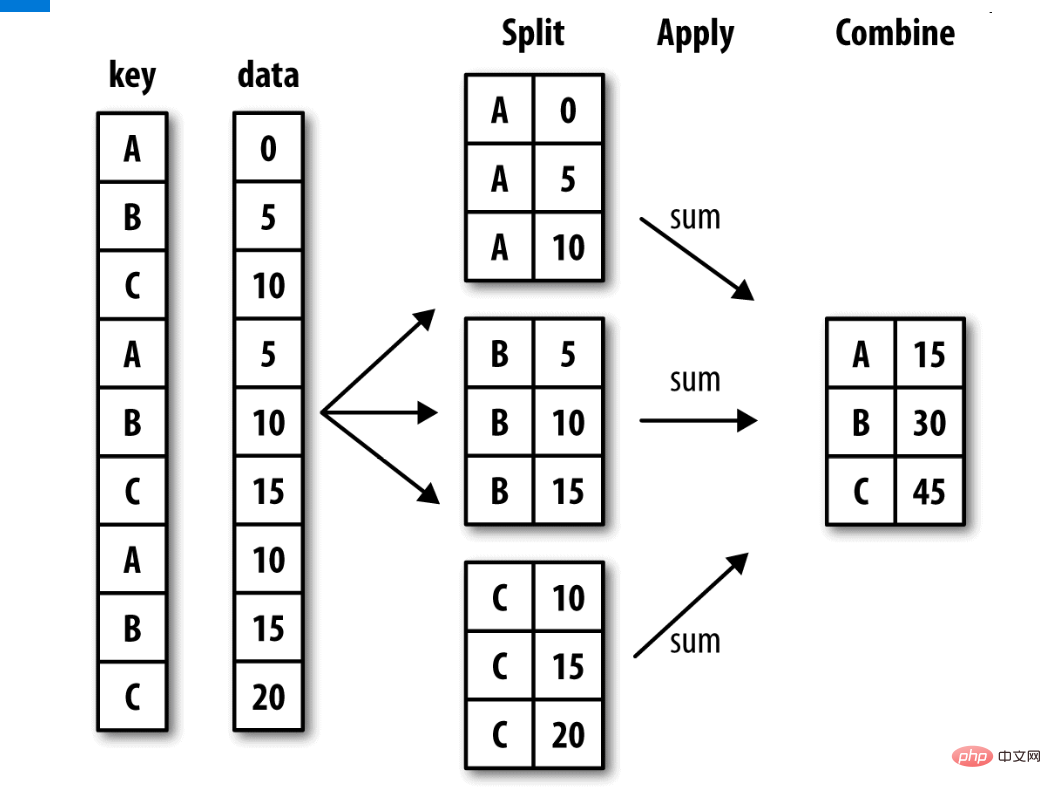
by:根据什么进行分组,用于确定groupby的组
as_index:对于聚合输出,返回以组便签为索引的对象,仅对DataFrame
df1 = pd.DataFrame({'fruit':['apple','banana','orange','apple','banana'],
'color':['red','yellow','yellow','cyan','cyan'],
'price':[8.5,6.8,5.6,7.8,6.4]})#查看类型type(df1.groupby('fruit'))pandas.core.groupby.groupby.DataFrameGroupBy #GruopBy对象,它是一个包含组名,和数据块的2维元组序列,支持迭代for name, group in df1.groupby('fruit'):
print(name) #输出组名
apple
banana
orange print(group) # 输出数据块
fruit color price 0 apple red 8.5
3 apple cyan 7.8
fruit color price 1 banana yellow 6.8
4 banana cyan 6.4
fruit color price 2 orange yellow 5.6
#输出group类型
print(type(group)) #数据块是dataframe类型
<class>
<class>
<class>#选择任意的数据块dict(list(df1.groupby('fruit')))['apple'] #取出apple组的数据块
fruit color price0 apple red 8.53 apple cyan 7.8</class></class></class>聚合
| 函数名 | 描述 |
|---|---|
| count | 分组中非NA值的数量 |
| sum | 非NA值的和 |
| mean | 非NA值的平均值 |
| median | 非NA值的中位数 |
| std, var | 标准差和方差 |
| min, max | 非NA的最小值,最大值 |
| prod | 非NA值的乘积 |
| first, last | 非NA值的第一个,最后一个 |
#Groupby对象具有上表中的聚合方法#根据fruit来求price的平均值df1['price'].groupby(df1['fruit']).mean()fruit
apple 8.15banana 6.60orange 5.60Name: price, dtype: float64
#或者df1.groupby('fruit')['price'].mean()# as_index=False(不把分组后的值作为索引,重新生成默认索引)df1.groupby('fruit',as_index=False)['price'].mean()
fruit price0 apple 8.151 banana 6.602 orange 5.60"""
如果我现在有个需求,计算每种水果的差值,
1.上表中的聚合函数不能满足于我们的需求,我们需要使用自定义的聚合函数
2.在分组对象中,使用我们自定义的聚合函数
"""#定义一个计算差值的函数def diff_value(arr):
return arr.max() - arr.min()#使用自定义聚合函数,我们需要将函数传递给agg或aggregate方法,我们使用自定义聚合函数时,会比我们表中的聚合函数慢的多,因为要进行函数调用,数据重新排列df1.groupby('fruit')['price'].agg(diff_value)fruit
apple 0.7banana 0.4orange 0.0Name: price, dtype: float64通过字典或Series对象进行分组:
m = {'a':'red', 'b':'blue'}people.groupby(m, axis=1).sum()s1 = pd.Series(m)people.groupby(s1, axis=1).sum()通过函数进行分组:
people.groupyby(len).sum()
时间序列(time series)数据是一种重要的结构化数据形式。
在多个时间点观察或测量到的任何时间都可以形成一段时间序列。很多时间, 时间序列是固定频率的, 也就是说, 数据点是根据某种规律定期出现的(比如每15秒…)。
时间序列也可以是不定期的。时间序列数据的意义取决于具体的应用场景。
主要由以下几种:
Python标准库包含用于日期(date)和时间(time)数据的数据类型,而且还有日历方面的功能。我们主要会用到datetime、time以及calendar模块。
datetime.datetime(也可以简写为datetime)是用得最多的数据类型:
In [10]: from datetime import datetime In [11]: now = datetime.now()In [12]: now Out[12]: datetime.datetime(2017, 9, 25, 14, 5, 52, 72973)In [13]: now.year, now.month, now.day Out[13]: (2017, 9, 25)
datetime以毫秒形式存储日期和时间。timedelta表示两个datetime对象之间的时间差:
In [14]: delta = datetime(2011, 1, 7) - datetime(2008, 6, 24, 8, 15)In [15]: delta Out[15]: datetime.timedelta(926, 56700)In [16]: delta.days Out[16]: 926In [17]: delta.seconds Out[17]: 56700
可以给datetime对象加上(或减去)一个或多个timedelta,这样会产生一个新对象:
In [18]: from datetime import timedelta In [19]: start = datetime(2011, 1, 7)In [20]: start + timedelta(12)Out[20]: datetime.datetime(2011, 1, 19, 0, 0)In [21]: start - 2 * timedelta(12)Out[21]: datetime.datetime(2010, 12, 14, 0, 0)

利用str或strftime方法(传入一个格式化字符串),datetime对象和pandas的Timestamp对象(稍后就会介绍)可以被格式化为字符串:
In [22]: stamp = datetime(2011, 1, 3)In [23]: str(stamp)Out[23]: '2011-01-03 00:00:00'In [24]: stamp.strftime('%Y-%m-%d')Out[24]: '2011-01-03'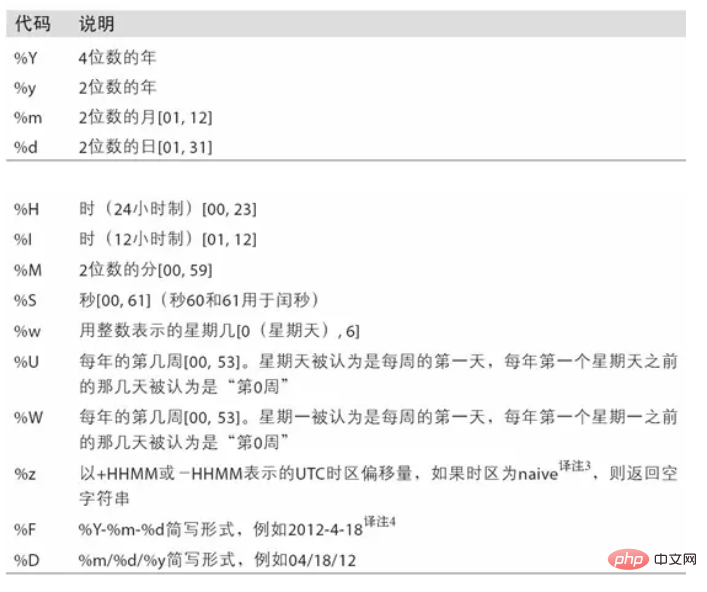
datetime.strptime可以用这些格式化编码将字符串转换为日期:
In [26]: datetime.strptime(value, '%Y-%m-%d')Out[26]: datetime.datetime(2011, 1, 3, 0, 0)In [27]: datestrs = ['7/6/2011', '8/6/2011']In [28]: [datetime.strptime(x, '%m/%d/%Y') for x in datestrs]Out[28]: [datetime.datetime(2011, 7, 6, 0, 0), datetime.datetime(2011, 8, 6, 0, 0)]
datetime.strptime是通过已知格式进行日期解析的最佳方式。但是每次都要编写格式定义是很麻烦的事情,尤其是对于一些常见的日期格式。
这种情况下,你可以用dateutil这个第三方包中的parser.parse方法(pandas中已经自动安装好了):
In [29]: from dateutil.parser import parse
In [30]: parse('2011-01-03')Out[30]: datetime.datetime(2011, 1, 3, 0, 0)dateutil可以解析几乎所有人类能够理解的日期表示形式:
In [31]: parse('Jan 31, 1997 10:45 PM')Out[31]: datetime.datetime(1997, 1, 31, 22, 45)在国际通用的格式中,日出现在月的前面很普遍,传入dayfirst=True即可解决这个问题:
In [32]: parse('6/12/2011', dayfirst=True)Out[32]: datetime.datetime(2011, 12, 6, 0, 0)Pandas通常是用于处理成组日期的,不管这些日期是DataFrame的轴索引还是列。to_datetime方法可以解析多种不同的日期表示形式。对标准日期格式(如ISO8601)的解析非常快:
In [33]: datestrs = ['2011-07-06 12:00:00', '2011-08-06 00:00:00']In [34]: pd.to_datetime(datestrs)Out[34]: DatetimeIndex(['2011-07-06 12:00:00', '2011-08-06 00:00:00'], dtype='datetime64[ns]', freq=None)
它还可以处理缺失值(None、空字符串等):
In [35]: idx = pd.to_datetime(datestrs + [None])In [36]: idx Out[36]: DatetimeIndex(['2011-07-06 12:00:00', '2011-08-06 00:00:00', 'NaT'], dty pe='datetime64[ns]', freq=None)In [37]: idx[2]Out[37]: NaT In [38]: pd.isnull(idx)Out[38]: array([False, False, True], dtype=bool)
NaT(Not a Time)是Pandas中时间戳数据的null值。
pandas最基本的时间序列类型就是以时间戳(通常以Python字符串或datatime对象表示)为索引的Series:
In [39]: from datetime import datetime In [40]: dates = [datetime(2011, 1, 2), datetime(2011, 1, 5), ....: datetime(2011, 1, 7), datetime(2011, 1, 8), ....: datetime(2011, 1, 10), datetime(2011, 1, 12)]In [41]: ts = pd.Series(np.random.randn(6), index=dates)In [42]: ts Out[42]: 2011-01-02 -0.2047082011-01-05 0.4789432011-01-07 -0.5194392011-01-08 -0.5557302011-01-10 1.9657812011-01-12 1.393406dtype: float64
这些datetime对象实际上是被放在一个DatetimeIndex中的:
In [43]: ts.index Out[43]: DatetimeIndex(['2011-01-02', '2011-01-05', '2011-01-07', '2011-01-08', '2011-01-10', '2011-01-12'], dtype='datetime64[ns]', freq=None)
跟其他Series一样,不同索引的时间序列之间的算术运算会自动按日期对齐:
In [44]: ts + ts[::2]Out[44]: 2011-01-02 -0.4094152011-01-05 NaN2011-01-07 -1.0388772011-01-08 NaN2011-01-10 3.9315612011-01-12 NaN dtype: float64
ts[::2] 是每隔两个取一个。
当你根据标签索引选取数据时,时间序列和其它的pandas.Series很像:
In [48]: stamp = ts.index[2]In [49]: ts[stamp]Out[49]: -0.51943871505673811
还有一种更为方便的用法:传入一个可以被解释为日期的字符串:
In [50]: ts['1/10/2011']Out[50]: 1.9657805725027142In [51]: ts['20110110']Out[51]: 1.9657805725027142
Pandas中的原生时间序列一般被认为是不规则的,也就是说,它们没有固定的频率。对于大部分应用程序而言,这是无所谓的。但是,它常常需要以某种相对固定的频率进行分析,比如每日、每月、每15分钟等(这样自然会在时间序列中引入缺失值)。
幸运的是,pandas有一整套标准时间序列频率以及用于重采样、频率推断、生成固定频率日期范围的工具。
例如,我们可以将之前那个时间序列转换为一个具有固定频率(每日)的时间序列,只需调用resample即可:
In [72]: ts
Out[72]: 2011-01-02 -0.2047082011-01-05 0.4789432011-01-07 -0.5194392011-01-08 -0.5557302011-01-10 1.9657812011-01-12 1.393406dtype: float64
In [73]: resampler = ts.resample('D')字符串“D”是每天的意思。
频率的转换(或重采样)是一个比较大的主题。这里,我将告诉你如何使用基本的频率和它的倍数。
虽然我之前用的时候没有明说,但你可能已经猜到pandas.date_range可用于根据指定的频率生成指定长度的 DatetimeIndex:
In [74]: index = pd.date_range('2012-04-01', '2012-06-01')In [75]: index
Out[75]: DatetimeIndex(['2012-04-01', '2012-04-02', '2012-04-03', '2012-04-04',
'2012-04-05', '2012-04-06', '2012-04-07', '2012-04-08',
'2012-04-09', '2012-04-10', '2012-04-11', '2012-04-12',
'2012-04-13', '2012-04-14', '2012-04-15', '2012-04-16',
'2012-04-17', '2012-04-18', '2012-04-19', '2012-04-20',
'2012-04-21', '2012-04-22', '2012-04-23', '2012-04-24',
'2012-04-25', '2012-04-26', '2012-04-27', '2012-04-28',
'2012-04-29', '2012-04-30', '2012-05-01', '2012-05-02',
'2012-05-03', '2012-05-04', '2012-05-05', '2012-05-06',
'2012-05-07', '2012-05-08', '2012-05-09', '2012-05-10',
'2012-05-11', '2012-05-12', '2012-05-13', '2012-05-14',
'2012-05-15', '2012-05-16', '2012-05-17', '2012-05-18',
'2012-05-19', '2012-05-20', '2012-05-21', '2012-05-22',
'2012-05-23', '2012-05-24', '2012-05-25', '2012-05-26',
'2012-05-27', '2012-05-28', '2012-05-29', '2012-05-30',
'2012-05-31', '2012-06-01'],
dtype='datetime64[ns]', freq='D')默认情况下,date_range会产生按天计算的时间点。如果只传入起始或结束日期,那就还得传入一个表示一段时间的数字:
In [76]: pd.date_range(start='2012-04-01', periods=20)Out[76]: DatetimeIndex(['2012-04-01', '2012-04-02', '2012-04-03', '2012-04-04', '2012-04-05', '2012-04-06', '2012-04-07', '2012-04-08', '2012-04-09', '2012-04-10', '2012-04-11', '2012-04-12', '2012-04-13', '2012-04-14', '2012-04-15', '2012-04-16', '2012-04-17', '2012-04-18', '2012-04-19', '2012-04-20'], dtype='datetime64[ns]', freq='D')In [77]: pd.date_range(end='2012-06-01', periods=20)Out[77]: DatetimeIndex(['2012-05-13', '2012-05-14', '2012-05-15', '2012-05-16', '2012-05-17', '2012-05-18', '2012-05-19', '2012-05-20', '2012-05-21', '2012-05-22', '2012-05-23', '2012-05-24', '2012-05-25', '2012-05-26', '2012-05-27','2012-05-28', '2012-05-29', '2012-05-30', '2012-05-31', '2012-06-01'], dtype='datetime64[ns]', freq='D')
起始和结束日期定义了日期索引的严格边界。
例如,如果你想要生成一个由每月最后一个工作日组成的日期索引,可以传入"BM"频率(表示business end of month),这样就只会包含时间间隔内(或刚好在边界上的)符合频率要求的日期:
In [78]: pd.date_range('2000-01-01', '2000-12-01', freq='BM')Out[78]: DatetimeIndex(['2000-01-31', '2000-02-29', '2000-03-31', '2000-04-28',
'2000-05-31', '2000-06-30', '2000-07-31', '2000-08-31',
'2000-09-29', '2000-10-31', '2000-11-30'],
dtype='datetime64[ns]', freq='BM')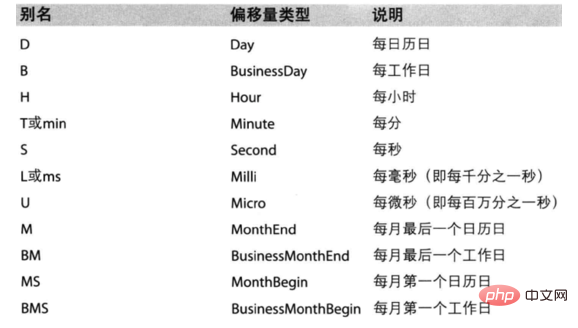
重采样(resampling)指的是将时间序列从一个频率转换到另一个频率的处理过程。
将高频率数据聚合到低频率称为降采样(downsampling),而将低频率数据转换到高频率则称为升采样(upsampling)。并不是所有的重采样都能被划分到这两个大类中。
例如,将W-WED(每周三)转换为W-FRI既不是降采样也不是升采样。
Pandas对象都带有一个resample方法,它是各种频率转换工作的主力函数。resample有一个类似于groupby的API,调用resample可以分组数据,然后会调用一个聚合函数:
In [208]: rng = pd.date_range('2000-01-01', periods=100, freq='D')In [209]: ts = pd.Series(np.random.randn(len(rng)), index=rng)In [210]: ts
Out[210]: 2000-01-01 0.6316342000-01-02 -1.5943132000-01-03 -1.5199372000-01-04 1.1087522000-01-05 1.2558532000-01-06 -0.0243302000-01-07 -2.0479392000-01-08 -0.2726572000-01-09 -1.6926152000-01-10 1.423830
... 2000-03-31 -0.0078522000-04-01 -1.6388062000-04-02 1.4012272000-04-03 1.7585392000-04-04 0.6289322000-04-05 -0.4237762000-04-06 0.7897402000-04-07 0.9375682000-04-08 -2.2532942000-04-09 -1.772919Freq: D, Length: 100, dtype: float64
In [211]: ts.resample('M').mean()Out[211]: 2000-01-31 -0.1658932000-02-29 0.0786062000-03-31 0.2238112000-04-30 -0.063643Freq: M, dtype: float64
In [212]: ts.resample('M', kind='period').mean()Out[212]: 2000-01 -0.1658932000-02 0.0786062000-03 0.2238112000-04 -0.063643Freq: M, dtype: float64resample是一个灵活高效的方法,可用于处理非常大的时间序列。
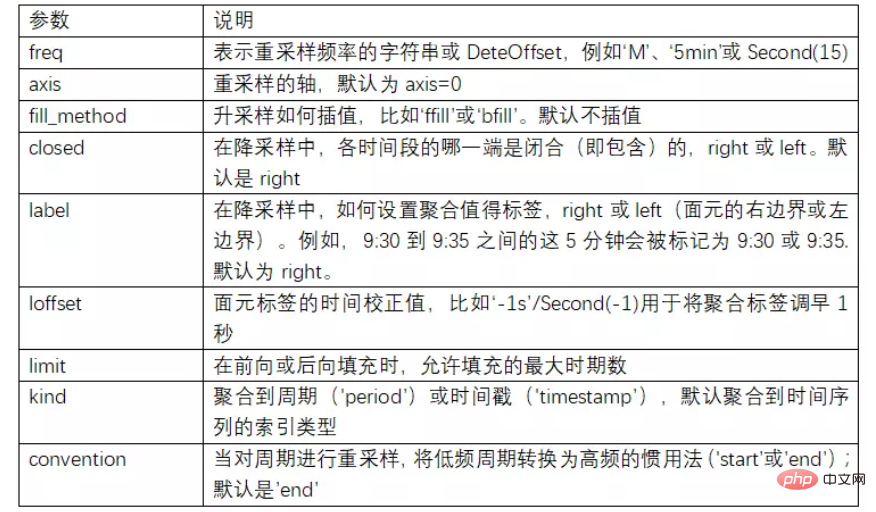
推荐学习:python视频教程
以上是詳細介紹Python之Pandas知識點的詳細內容。更多資訊請關注PHP中文網其他相關文章!

